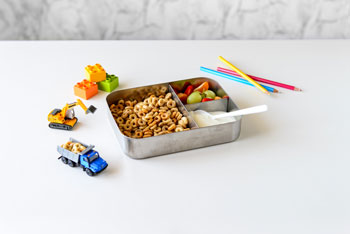Dr Kellie Bilinski Back To School Tips Interview

Breakfast Choice Matters When It Comes to Kids Nutrition
A new Australian study has examined breakfast habits of Australian children looking at what they ate and how it impacted their nutrient and sugars intakes.
The Nutrition Research Australia (NRA) study, published in the international journal Nutrients, analysed data from the ABS Australian Health Survey. Five of the key findings included…
Easy brekkie gets nutrition tick - Grabbing a bowl of breakfast cereal for your children may be more than a quick-fix to help manage the morning rush. The good news is that as well as being the most popular way to start the day, it also gets a big nutrition tick. The NRA study showed Australian children that started their day with breakfast cereal had the highest intakes of dietary fibre and nutrients including calcium and iron – key nutrients where Australian children are falling short. In fact compared to children that ate other foods for breakfast, cereal eaters had 32% more iron, 30% more riboflavin, 23% more calcium, and 9% less salt in their daily diets. It also found the nutritional benefits were consistent, regardless of the total sugars* content of the breakfast cereal eaten.
Troubled Teens - Growth spurts and changing bodies mean teens have greater nutritional needs, but their breakfast habits could be robbing them of important vitamins and minerals. The NRA study revealed teens were more likely to have skipped breakfast and less likely to have eaten breakfast cereal – two breakfast habits the research linked with lower nutrient intakes.
Let's Talk Sugar - The NRA study showed there was no difference in the amount of added sugars** in children's diets, no matter whether they started the day by eating breakfast cereal or other breakfast foods, like toast and spreads. There was also no difference in their kilojoule intakes, but cereal eaters had healthier diets that were higher in vitamins and minerals.
Milking it – Starting the day with breakfast cereal also helped to boost the amount of milk children were getting. Dairy milk is the top source of calcium in the diets of Australian children and also provides magnesium, potassium and riboflavin. The NRA study showed children that started their day with cereal were three times more likely to have milk on a daily basis than children that skipped breakfast or ate other foods for breakfast.
Skippers missing out – Almost one in ten Australian children headed off to school or play without breakfast, according to the NRA study. Those who skipped breakfast also missed out on getting important nutrients needed for growth and development with the researchers reporting they had the lowest daily intakes of most nutrients and dietary fibre. Most (61%) children skipping breakfast were in their mid to late teens (aged 14 to 18 years).
 Interview with Dr Kellie Bilinski, Accredited Practising Dietitian and mum of three
Interview with Dr Kellie Bilinski, Accredited Practising Dietitian and mum of three
Question: Why is breakfast the most important meal for school aged children?
Dr Kellie Bilinski: Breakfast really does give your kids the best possible start to the day. After a big night's sleep, it's vital to fuel their growing bodies and brains so they are ready to tackle the school day. As well as providing energy, a good breakfast can help improve their grades and helps them beat the -fuzzies', or poor concentration, that can set in with the mid-morning hunger pangs.
Question: Why do you believe a good-quality breakfast improves literacy and numeracy grades?
Dr Kellie Bilinski: Eating breakfast improves brain function helping children perform better at school in problem solving, creative and mathematical tasks. The benefits are related to the nutritional quality of the breakfast and the fact that breakfast eaters tend to have more nutritious diets overall.
Question: What would the perfect breakfast look like for a primary-aged school child?
Dr Kellie Bilinski: It's important to remember that a healthy brekkie can be quick, easy and budget friendly. It's good to try and aim for three foods groups, something like baked beans on toast with a glass of milk or cereal with milk and fruit. In fact the latest Australian Bureau of Statistics data showed kids that that started their day with breakfast cereal had the healthiest diets.
Question: How does the perfect breakfast differ for high-school-aged children?
Dr Kellie Bilinski: They just need more! To cope with growth spurts and changing bodies teenagers generally need more protein and calories. So that might look like a bowl of cereal, some peanut butter on toast and a glass of milk plus a piece of fruit to go. The challenge with teens is that they are much more likely to skip breakfast and therefore miss out on the important vitamins and minerals they need.
To help try and break this habit, it may help for parents to have on-the-run breakfast options at the ready, or make a breakfast smoothie teens can take with them. This can be as simple as blending up cereal, milk and their favourite fruit.
Question: What's a typical breakfast look like, for you?
Dr Kellie Bilinski: I have three young kids, so for me it's important that their breakfast is healthy and nourishing, but also manageable in the morning rush. My kids tend to have either a couple of pieces of toast and vegemite or peanut butter or a bowl of cereal with yoghurt and banana on top. They'll usually make a fruit smoothie with some oats, yoghurt, frozen berries, banana and milk with that to keep them going.
Question: As a Mum of three, how do you find the time to ensure your children have well-balanced meals?
Dr Kellie Bilinski: I always try to make sure I've got a variety of breakfast cereals and some grainy bread in the freezer plus I do keep a supply of longlife milk in case we run out. We've always emphasised eating plenty of healthy food, rather than focusing on what the -shouldn't' have too much of. Hopefully the years of eating well have been well established that's just the way they normally eat.
Question: What should we find in the perfect lunchbox?
Dr Kellie Bilinski: Just like breakfasts, your kid's lunch box doesn't have to be Insta-worthy. Keeping it simple is a good way to go – think seasonal fruit either whole or in segments, veggie sticks to snack on, a sandwich with a protein such as chicken or tuna. You could also incorporate dinner leftovers, if you're cooking pasta why not make a bigger batch for the next days lunch – this also saves prep time!
Interview by Brooke Hunter
MORE



